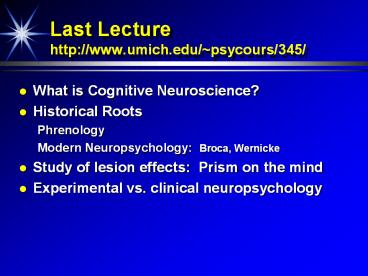Last%20Lecture%20http://www.umich.edu/~psycours/345/ - PowerPoint PPT Presentation
Title:
Last%20Lecture%20http://www.umich.edu/~psycours/345/
Description:
http://www.umich.edu/~psycours/345/ What is Cognitive Neuroscience? Historical Roots Phrenology Modern Neuropsychology: Broca, Wernicke Study of lesion effects: Prism ... – PowerPoint PPT presentation
Number of Views:146
Avg rating:3.0/5.0
Title: Last%20Lecture%20http://www.umich.edu/~psycours/345/
1
Last Lecture http//www.umich.edu/psycours/345/
- What is Cognitive Neuroscience?
- Historical Roots
- Phrenology
- Modern Neuropsychology Broca, Wernicke
- Study of lesion effects Prism on the mind
- Experimental vs. clinical neuropsychology
2
Todays Lecture
- Getting around the brain
- Orientational Terminology
- Gross Neuroanatomy
- Maps
- Cytoarchitectonic
- Projections Maps
3
Directional Terms
4
Planes of Section
- Frontal plane coronal section
- Sagittal plane medial and parasagittal section
- Horizontal plane transaxial or horizontal
section
5
Planes of Section
- Frontal plane coronal section
6
Planes of Section
- Sagittal plane medial parasagittal section
7
Planes of Section
- Horizontal plane horizontal or transaxial
section
8
Photo
PET
9
(No Transcript)
10
(No Transcript)
11
Major Subdivisions Forebrain, Midbrain,
Hindbrain
- Hindbrain
- Medulla
- Pons
- Cerebellum
- Midbrain
- superior colliculus
- inferior colliculus
- Motor nuclei
12
Major Subdivisions Forebrain, Midbrain,
Hindbrain
- Hindbrain
- Medulla
- Pons
- Cerebellum
- Midbrain
- superior colliculus
- inferior colliculus
- Motor nuclei
13
- Forebrain
- neocortex/cortex
- limbic system
- basal ganglia
- olfactory system
- thalamus / hypothalamus
14
Our primary focus Neocortex
- Phylogenetically youngest structure
- Well developed only in mammals
- Accounts for 9 billion of the 12 billion neurons
in the human nervous system.
15
- Terminology (for a convoluted surface)
- Fissure Deep cleft
- Sulcus Shallow cleft
- Gyrus Ridge
- Major Landmarks
- Longitudinal Fissure separates Left Right
hemispheres - Central Fissure separates parietal and frontal
- Lateral (Sylvian) Fissure
- dorsal boundary of temporal lobe
16
Four Lobes
- Named for overlying skull bones
- Offer "crude" functional (sensory-motor) parse
- Frontal voluntary motor control
- Parietal somatosensory
- Temporal auditory
- Occipital visual
17
(No Transcript)
18
Blood Supply to the Brain (highlights)
- Internal Carotid arteries- supply only cortex
- anterior cerebral artery
- middle cerebral artery
- Vertebral Arteries- supply brainstem, cerebellum
and cortex - posterior cerebral artery
- occipital, temporal lobes
- tectum
19
(No Transcript)
20
Principles of Cortical Organization
Cytoarchitectonic Maps Projection Maps
- Map
- system for classifying defining cortical
organization - orderly representation on cortical surface
- structural basis for defining an area's function
- function can follow closely from structure (e.g.
projection maps)
21
(No Transcript)
22
Cytoarchitecture
- Gray matter is 2 mm thick.
- 6 layers differing in number, type, density of
cells. - 2 4 receiving layers
- fibers from sensory and association cortex
- thicker in sensory cortex
- 3, 5 6 sending layers
- 3 association cortex and commissures
- 5 brainstem and spinal cord
- 6 thalamus
- thicker in motor cortex
- Thalamocortical, corticothalamic
Corticocortical connections (intra and
interhemispheric)
23
Cytoarchitectonic Maps Complex micro-structure
of neural tissue
- Brodmann's (1909) Map
- Classified regions based on density of cell
layers - Identified about 50 distinct areas
- Structural classification --gt functional
differences - system widely used to refer to areas of interest.
24
Cytoarchitectonic Maps Complex micro-structure
of neural tissue
- Brodmann's (1909) Map
- Classified regions based on cell layers
- Identified 52 areas
- Structural classification --gt functional
differences - system widely used to refer to areas of interest.
25
Projection Maps
- defined by their input
- What gets mapped depends on the sensory modality
- vision-- visual space
- auditory-- pitch (frequency)
- touch-- body surface
26
Generic (simplified) Pathway
- Properties of Cortical
- Organization
- Hierarchical Organization
- ranking based on modality specificity
complexity of functions - Contralateral Organization
- e.g. LH represents
- Right Visual Field
- Right side of body
- Right Ear Input
- Vice versa for RH
- Functional Segregation
- modules with specialized functions































